Have you ever thought about adopting minimalism in your work environment? Minimalism is a lifestyle that seeks to simplify things, eliminating excess and focusing on the essentials. And this philosophy can also be applied to the way we work.
In the professional environment, minimalism can bring a series of benefits, from increasing productivity to reducing stress. But how do you start working with minimalism and adopt this approach into your routine?
In this practical guide, I will provide tips and strategies to help you with this minimalist journey at work. You will discover how to start this journey, the benefits that minimalism can bring to your professional life and how to organize your work environment to increase efficiency.
Main points of the guide:
- Learn what minimalism is and how to apply it at work;
- Discover how to start working with minimalism and the benefits it brings;
- Receive tips for implementing minimalism in the workplace and simplifying your tasks;
- Learn how to create an organized and minimalist work environment;
- Explore minimalist decor and the impact it can have on your productivity;
- Discover strategies for dealing with minimalism in professional relationships;
- Learn how to achieve productivity through minimalism and efficient time management;
- Discover minimalist project management techniques;
- Discover how minimalism can be applied to other areas of life besides work;
- Conclusion: find out how minimalist journey It can transform your professional and personal life.
Important Conclusions
- Minimalism can bring more efficiency and productivity to your work routine;
- A minimalist organization and simplifying tasks can reduce stress and wasted time;
- Creating a clean and minimalist work environment can improve focus and creativity;
- Minimalism is not limited to work, but can positively influence your life as a whole;
- A minimalist journey It requires commitment and awareness in your daily choices.
What is minimalism?
To understand minimalism, it is essential to understand its meaning and how it applies to the workplace. Minimalism is a lifestyle that seeks live with less, simplify things and eliminate the excess information and objects that surround us. In the professional context, the minimalism at work It means adopting a simplified and mindful approach to tasks, workspaces and professional relationships.
Living with less at work involves reducing the number of unnecessary responsibilities and tasks, focusing on those that are truly essential. simplify life professional involves eliminating clutter, both physical and mental, and seeking a minimalist organization that promotes efficiency and clarity in daily activities.
O minimalism at work It's not just about having a clean table and simple decor items. It is a holistic approach that seeks to optimize the way we work, relate to colleagues and deal with everyday challenges. To the simplify life As a professional, we can experience benefits such as increased productivity, improved focus, reduced stress, and a sense of clarity and purpose in our activities.
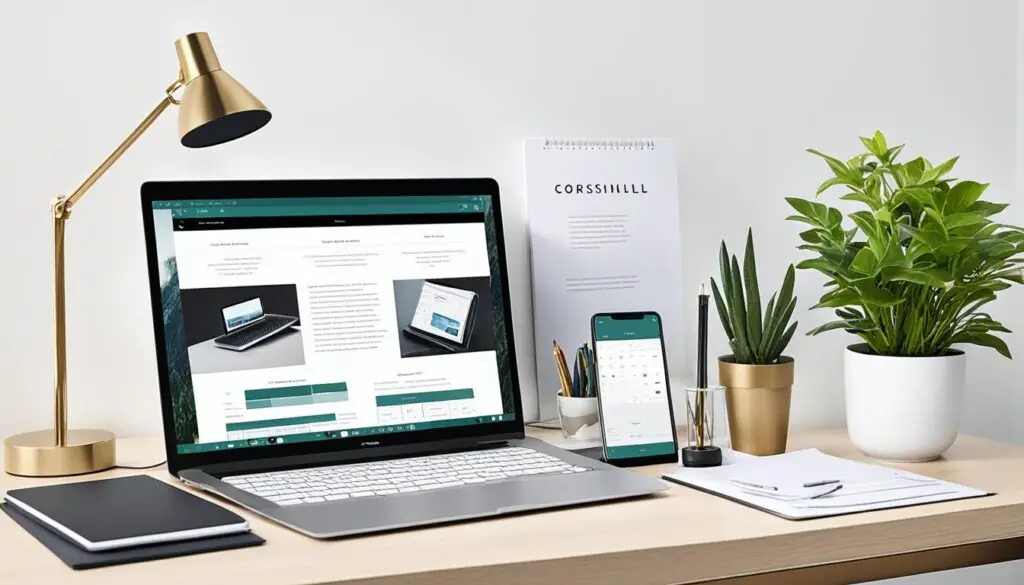
In the next section, we'll look at how to start implementing minimalism in the workplace. Let's discover practical strategies for organizing the workspace, simplify tasks and establish meaningful connections with other professionals. Follow our practical guide on how to work with minimalism!
How to start working with minimalism
Often, clutter and lack of organization can make it difficult to perform tasks in the workplace. Therefore, adopting a minimalist organization It can be an effective solution to increase productivity and well-being at work.
Minimalist organization involves simplifying your workspace, having only what you need and eliminating distractions. By implementing this approach, you can experience a number of benefits of minimalism for your professional life.
Benefits of minimalism at work
Minimalism in the workplace can bring several benefits to your productivity and well-being. Some of the key benefits include:
- Stress reduction: Organized and clean environments have the potential to reduce stress and feelings of overwhelm.
- Maior focus and concentration: Eliminating distractions and keeping only the essentials in your workspace can help improve focus and concentration on tasks.
- Increased efficiency: With less clutter and efficient organization, it's easier to find what you need and complete tasks faster and more efficiently.
- Feeling of calm and well-being: An organized and clutter-free work environment can contribute to a general feeling of calm and well-being.
Knowing where to start can be a challenge. Here are some practical strategies to help you get started with minimalism.
Minimalist organization strategies for the workplace
- Cleaning and organizing: Take time to clean and organize your workspace. Remove unnecessary items such as unused paper and office supplies. Keep only what is essential for your work.
- Proper storage: Utilize proper storage systems, such as drawers, shelves, and organizers, to keep your essential items organized and easily accessible.
- Scan documents: Scan important documents and files to reduce the amount of paper in your workspace. Store digital files in an organized way for easy access and search.
- Use lists and calendars: Create to-do lists and use calendars to keep a clear record of what needs to be done. This will help you stay focused and feel more organized.
By adopting these minimalist organization strategies, you'll be on your way to a more efficient, productive, and stress-free workplace.
Surrounding yourself with only what you need allows you to focus on what really matters.
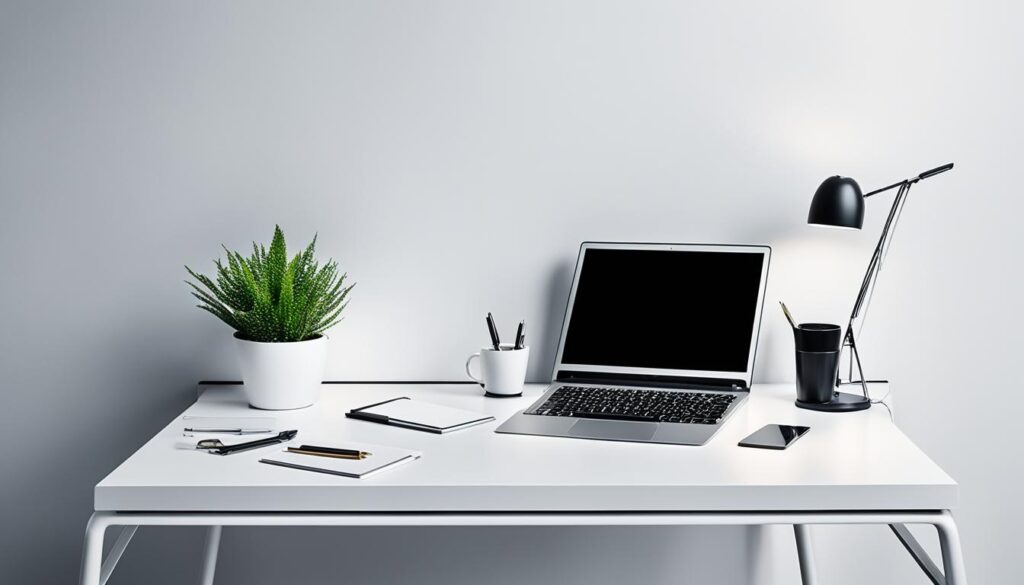
| Traditional Organization | Minimalist Organization |
|---|---|
| Disorganized work environment full of unnecessary items | Clean, organized and clutter-free work environment |
| Difficulty finding important items and documents | Easy access to essential items and documents |
| Waste of time searching for information | Less time spent searching for information |
| Constant feeling of overload and clutter | Feeling of calm and mental clarity |
Tips for implementing minimalism at work
Implement the minimalism at work can simplify tasks, reduce clutter and increase productivity. Here are some practical tips to get started:
- Simplify your tasks: Analyze your responsibilities and focus on what is essential. Eliminate unnecessary tasks and delegate when possible. This will help you reduce overwork and focus on what really matters.
- Create an organized work environment: Reduce clutter in your workspace. Keep only what you need on your desk and find an organization system that works for you. This will help reduce distractions and stay focused on important tasks.
- Set clear priorities: When defining your goals and priorities, set realistic limits. Focus on tasks that have the greatest impact and avoid work overload. This will allow you to focus on what's really important and avoid the feeling of being constantly overwhelmed.
- Use productivity tools: There are several tools available that can help simplify tasks and improve your productivity. Explore time management apps, collaboration tools, and task organizers to streamline your workflow.
- Practice digital minimalism: Reduce digital clutter, clean up your email inbox, and eliminate unnecessary files. Organize your files and folders logically and remove apps or notifications that are not essential for your work.
Remember that implementing minimalism at work is an ongoing process. It's not just about simplifying the physical environment, but also adopting a mindset focused on the essentials. By simplifying tasks, reduce clutter and optimize your workflow, you will be creating an environment conducive to minimalist productivity.
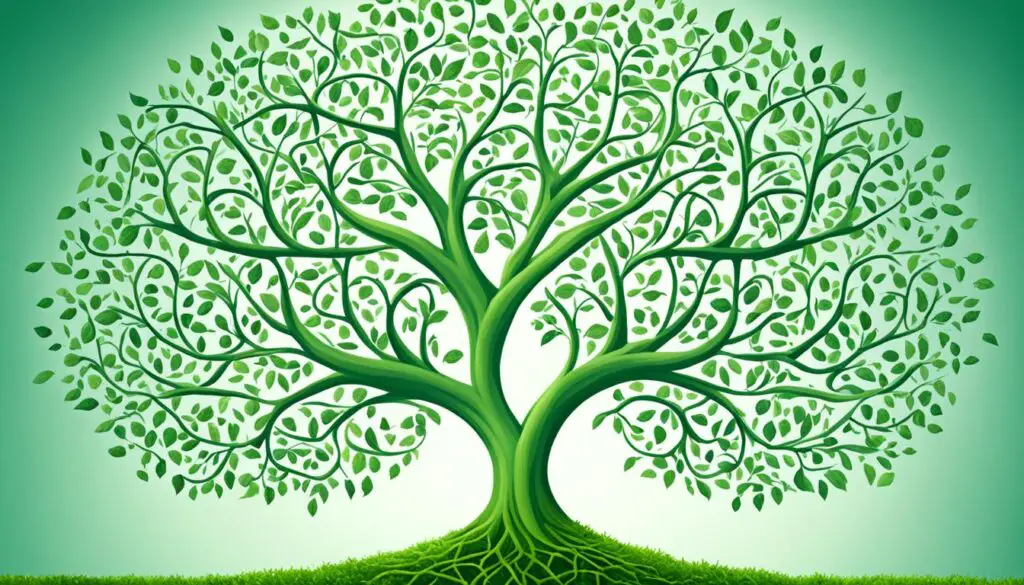
| Benefits of Minimalism at Work | Strategies for Implementing Minimalism |
|---|---|
| Increased productivity | Simplify tasks |
| Stress reduction | Reduce clutter |
| Maior focus and concentration | Create an organized work environment |
| Improved decision making | Set clear priorities |
| Better work-life balance | Use productivity tools |
Minimalist organization for the workplace
In the workplace, organization is essential to create a clean space conducive to productivity. One minimalist workspace provides a calm, distraction-free environment, allowing you to focus on important tasks. A space optimization It can also positively influence your efficiency and creativity.
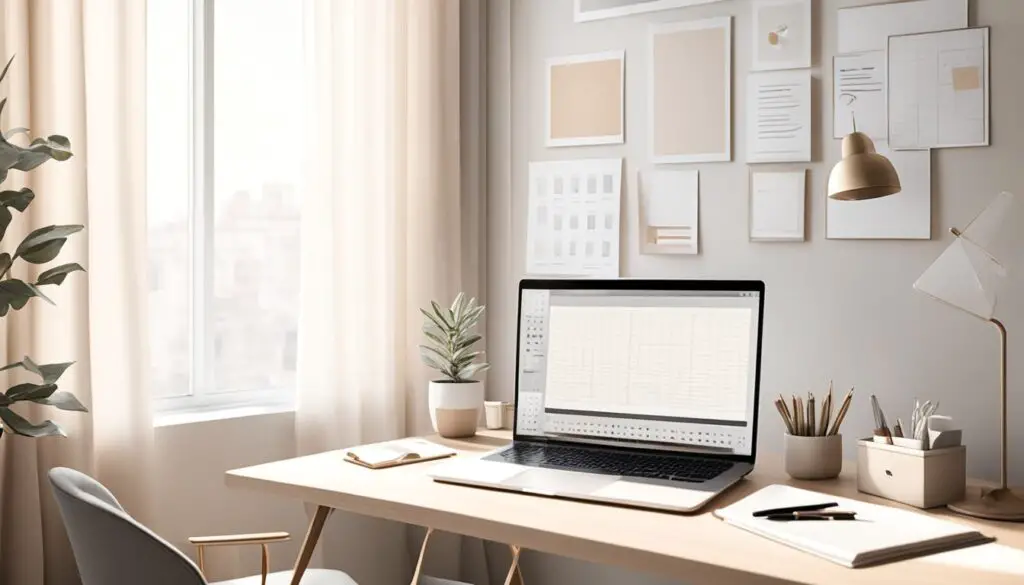
Tips for creating a clean and minimalist environment:
- Keep a clean and organized desk, leaving only essential items at hand.
- Use organizers and drawers to store documents and office supplies.
- Eliminate digital clutter by keeping files and folders organized on your computer.
- Invest in good natural lighting to create a more pleasant environment.
- Use neutral colors in decoration, avoiding excess visual elements.
- Use stickers or stickers to identify folders and objects, making them easier to find.
Through these minimalist organization tips, you can create a harmonious workspace, where each item has its place and your mind can focus on what really matters. An orderly desktop leads to mental clarity and efficiency.
“A clean and organized environment is essential for productivity and creativity at work.” – Steve Jobs
In addition, a clean environment and minimalist design provides a feeling of calm and tranquility, contributing to well-being at work. By optimizing space and creating a harmonious environment, you will be creating the ideal conditions to carry out your tasks and achieve your professional goals.
| Minimalist Organization Tips for the Workplace |
|---|
| Keep a clean and organized desk |
| Use organizers and drawers to store documents and office supplies |
| Eliminate digital clutter by keeping files and folders organized on your computer |
| Invest in good natural lighting to create a more pleasant environment |
| Use neutral colors in decoration, avoiding excess visual elements |
| Use stickers or stickers to identify folders and objects, making them easier to find |
Minimalist decoration in the workplace
When it comes to creating a productive and inspiring work environment, minimalist decor plays a key role. A clean decor and simplified is a trend that is gaining more and more followers, and it's no wonder. O aesthetic minimalism, in addition to bringing a feeling of tranquility and organization, it also contributes to concentration and creativity.
When adopting minimalist decor in the workplace, it is important to keep some basic principles in mind. Prioritize functionality and avoid excess decorative objects. Choose furniture with simple lines and neutral colors, which convey a feeling of harmony. Organization is key, so keep your workspace clean and clutter-free.
Also, remember that minimalist decor does not mean an absence of personality. You can add touches of color and elements that reflect your identity, as long as they are balanced. For example, a plant or a piece of art can transform your work environment into an inspiring and welcoming space.
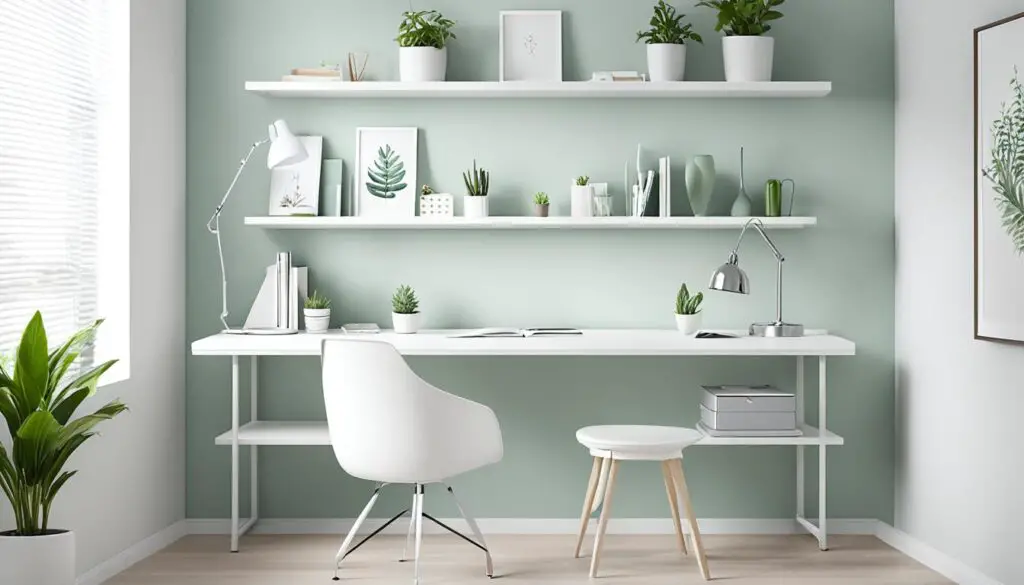
The minimalist work environment contributes to a clear, distraction-free mind, allowing you to focus on tasks more efficiently. Additionally, an organized and inspiring space can help stimulate your creativity and motivation.
Minimalist decorating tips:
- Choose functional furniture with simple lines;
- Use neutral colors to create a calm and balanced atmosphere;
- Keep the space free of clutter and unnecessary objects;
- Add decorative elements sparingly, such as plants or artwork;
- Invest in adequate lighting for the work environment;
- Create a rest or meditation area for moments of pause and relaxation;
- Use organizers and boxes to keep your materials and documents in order.
However, remember that minimalist decor should suit your work style and needs. The most important thing is to create an environment that is functional, inspiring and capable of reflecting your personality.
Dealing with minimalism in professional relationships
In the workplace, the adoption of minimalism is not limited to physical organization and simplified processes. Dealing with minimalism in professional relationships is essential for a efficient collaboration e meaningful connections.
A minimalist communication plays a fundamental role in this process. By adopting a clear, objective and concise approach to communication, it is possible to transmit information more effectively, avoiding noise and misunderstandings.
Furthermore, minimalist communication promotes a space for open and respectful dialogue, where everyone has the opportunity to contribute in a meaningful way. By actively listening and showing genuine interest, you can make deeper connections and build stronger professional relationships.
“A minimalist communication It’s like a bridge that connects people in a clear and meaningful way, allowing ideas and information to flow efficiently.”
A efficient collaboration It is also essential for dealing with minimalism in professional relationships. By adopting a collaborative approach, it is possible to leverage complementary skills, share knowledge and achieve better results as a team.
One of the efficient collaboration It is based on trust, mutual respect and a willingness to listen and consider different perspectives. By working collaboratively, it is possible to achieve innovative solutions and achieve common goals more quickly.
Tips for dealing with minimalism in professional relationships:
- Practice clear and objective communication, conveying essential information concisely.
- Be an active listener and show genuine interest in the contributions of others.
- Promote a culture of collaboration, encouraging the exchange of ideas and knowledge.
- Establish clear, shared goals for team projects.
- Value the team's complementary skills and take advantage of each member's strengths.
- Be respectful and open to different perspectives and opinions.
- Create an environment where everyone feels comfortable sharing ideas and contributing.
By adopting minimalist communication and efficient collaboration, you can create a productive work environment where professional relationships are based on meaningful connections. In this way, minimalism is not just limited to physical organization, but extends to the essence of teamwork and building healthy professional relationships.

How to Achieve Minimalist Productivity
To achieve productivity in the workplace through minimalism, it is important to adopt effective management strategies. time management, focus and concentration, in addition to developing an approach to professional efficiency. Below are some valuable tips to help you on this minimalist journey towards productivity:
Time management
One of the keys to productivity is proper time management. To achieve this, it is essential to plan your tasks efficiently and prioritize those that are most important. Use techniques like the Eisenhower matrix, which help you distinguish between urgent and important tasks, allowing you to optimize your time and direct your energy towards activities that truly add value.
Focus and concentration
In today's world, it's easy to get distracted by countless demands and constant notifications. To maintain focus and concentration while working, it is essential to minimize distractions. Turning off cell phone notifications, setting a specific time to check emails and social networks, as well as creating a work environment free from visual and sound distractions, are effective strategies for increasing your productivity and ensuring a more fluid workflow.
Efficient Professional
Looking for ways to optimize and simplify your professional tasks is also an important practice of minimalism. Automating repetitive processes, using efficient tools and software, and delegating tasks when possible are effective strategies to increase your productivity. professional efficiency and avoid the accumulation of unnecessary work.
“A minimalist productivity It is achieved when we focus on what is essential and eliminate what distracts us.”
- Unknown author
In addition to these tips, remember to maintain a healthy lifestyle with good nutrition, exercise and adequate sleep. These basic precautions are essential to ensure high levels of energy and well-being in the work environment.
| Strategies | Benefits |
|---|---|
| Efficient task planning | Greater organization and focus on work |
| Minimize distractions | Increased productivity and quality of work |
| Optimize and simplify tasks | Maior professional efficiency and stress reduction |
By implementing these strategies into your work routine, you will be on your way to achieving a minimalist productivity and enjoy the benefits of a lighter and more efficient approach in the professional environment.

Minimalist project management
In the workplace, project management can be a complex and demanding task. However, taking a minimalist approach can simplify this process, increasing efficiency and productivity.
For simplified planning, it is important to identify the essential steps of each project and eliminate any excess details that could hinder understanding and execution. Prioritize the key information that will truly impact the final result.
A efficient prioritization is another crucial aspect in minimalist project management. When establishing tasks and activities, take into account the importance and urgency of each one. Use categorization techniques, such as the Eisenhower Matrix, to determine priorities objectively.
Furthermore, it is essential to maintain a minimalist organization when dealing with projects. Use digital or physical tools that allow a clear and simplified view of the project, such as Kanban boards or task management applications.
In minimalist project management, the focus is on simplicity and efficient results. By simplifying planning, prioritizing tasks efficiently, and maintaining a minimalist organization, you will create an environment conducive to productivity and success.

Implementing minimalist project management can bring several benefits, such as greater clarity, reduced stress and better use of available resources. By simplifying and prioritizing, you will be directing your energy towards the most relevant and impactful project activities.
“Simplicity is the ultimate degree of sophistication.” – Leonardo da Vinci
With minimalist project management, you will be maximizing your efficiency and optimizing your results. Apply these techniques to your work environment and discover how minimalist organization can transform the way you manage and deliver your projects.
Minimalism beyond work
In this section, we will explore how minimalism can go beyond work and be applied to other areas of personal life. Finding a healthy balance between work and personal life is essential for well-being and happiness. Minimalism can be an effective approach to achieving this balance.
O work-life balance It is essential to have a full and satisfying life. Often, we dedicate ourselves so much to work that we neglect other important areas of our lives, such as family, relationships and self-care. O minimalism in personal life seeks to simplify and prioritize what is truly essential, so that we can dedicate time and energy to the things that matter most.
Here are some tips for incorporating the minimalism in personal life:
- Prioritize quality time with family and friends. Take moments to be present and enjoy the meaningful connections in your life.
- Analyze the activities and commitments that consume your time and energy. Identify what is really important and eliminate what does not contribute to your well-being.
- Simplify your finances. Evaluate your expenses and identify areas where you can reduce and save. Living with less it can also mean having less debt and financial worries.
- Create organized, inspiring spaces at home. Try to only keep items that are functional or that truly bring joy and meaning.
Also look for moments of self-care and relaxation. O minimalism in personal life It involves taking care of yourself and making time for activities that provide pleasure and well-being.
“Simplicity is the ultimate degree of sophistication.” – Leonardo da Vinci
Through minimalism in our personal lives, we can find a healthy balance between work and other areas of our lives. This approach helps us value what really matters, simplify and create a more balanced and meaningful life.
Seeking balance between work and personal life
Finding a healthy balance between work and personal life can be challenging, especially in a world where we are constantly connected and available. Minimalism in your personal life offers a way to prioritize what's really important and make time for the things that make us happy.
Here are some tips for achieving work-life balance:
- Establish clear boundaries between work and personal life. Set specific times to work and disconnect from work. Avoid taking work home or responding to emails outside of work hours unless absolutely necessary.
- Learn to say “no” when necessary. Don't overload yourself with extra tasks or commitments that aren't really important. Prioritize your time and energy for the things that are essential and meaningful both at work and in your personal life.
- Practice self-care regularly. Take time to take care of yourself, whether through hobbies, exercise, meditation or simply resting. Self-care is essential for balance and well-being.
- Look for activities that provide pleasure and relaxation. Find time to do the things you love, whether it's reading a book, listening to music, walking outdoors or spending time with your loved ones.
Remember that work-life balance is unique to each individual. What works for one person may not work for another. Try different strategies and find what works best for you.
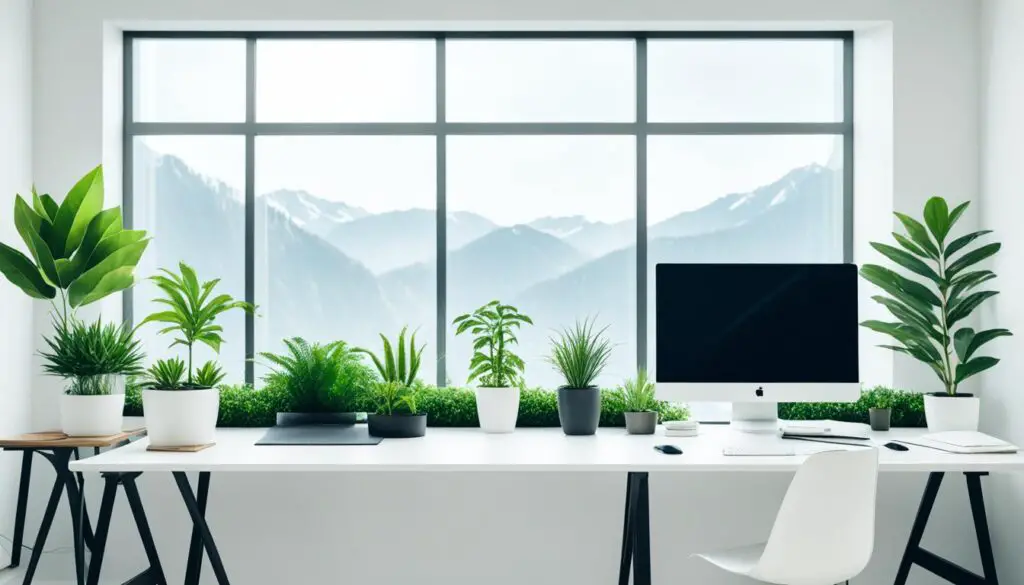
| Benefits of minimalism in personal life | Strategies for achieving balance |
|---|---|
| Greater happiness and overall satisfaction | Establish specific times for work and leisure |
| Reduction of stress and anxiety | Practice self-care regularly |
| Improved physical and mental health | Learn to say “no” when necessary |
| Better quality of life | Look for pleasurable activities |
Conclusion
In this final section, I conclude our practical guide on how to work with minimalism. During this minimalist journey, we explore the different ways to apply this lifestyle in the professional environment and the benefits it can bring to both your professional and personal life.
Adopt one minimalist lifestyle it can result in increased productivity, reduced stress, and better work-life balance. Through minimalist organization and focusing on the essentials, we can simplify our tasks, optimize our workspace, and create a inspiring environment.
If you want to continue exploring minimalism, next steps include regularly evaluating your practices, adjusting as needed, and staying committed to your minimalist journey. Remember, minimalism isn't just about having less stuff, it's also about focusing on what's really important to you and creating a more meaningful and balanced life.
FAQ
Q: What is minimalism?
A: Minimalism is a lifestyle that seeks to simplify, reduce excess and live with less. In the workplace, minimalism applies to organization and work mentality, prioritizing the essentials and eliminating what is not necessary.
Q: How to start working with minimalism?
A: To start working with minimalism, it's important to organize your work environment, eliminate unnecessary objects and adopt a simpler approach to tasks and projects. Minimalism also involves managing time efficiently and seeking a balance between productivity and well-being.
Q: What are the benefits of minimalism at work?
A: Minimalism at work can bring several benefits, such as increased productivity, reduced stress, increased creativity and a feeling of calm and mental clarity. Additionally, minimalism helps maintain an organized work environment, which facilitates workflow and decision-making.
Q: What are your tips for implementing minimalism at work?
A: Some tips for implementing minimalism at work include simplifying tasks, reducing clutter in the workplace, creating efficient routines and organization systems, and prioritizing the most important tasks. Furthermore, it is essential to develop efficient communication and collaboration skills in the workplace.
Q: How to create a minimalist work environment?
A: To create a minimalist work environment, it is important to keep the space clean and organized, optimize the workspace to make it more functional, and decorate it in a minimalist way, focusing on neutral colors and simple elements. A minimalist environment reduces distractions and contributes to productivity and well-being at work.
Q: What are the strategies for dealing with minimalism in professional relationships?
A: To deal with minimalism in professional relationships, it is important to adopt a clear and objective communication approach, collaborate efficiently with coworkers, and seek meaningful connections with people who share the same professional values and goals.
Q: How to achieve minimalist productivity?
A: To achieve minimalist productivity, it is essential to manage time efficiently, establish clear and realistic goals, maintain focus and concentration on the most important tasks, and develop organization and prioritization skills.
Q: What are the minimalist project management techniques?
A: To manage projects in a minimalist way, you need to simplify planning, prioritize tasks and activities efficiently, and maintain a minimalist organization when dealing with deadlines and demands. Minimalist project management aims to eliminate excess and focus on the essentials to achieve efficient results.
Q: How to apply minimalism beyond work?
A: Minimalism can be applied to other areas of personal life, such as home and finances. It is possible to seek a balance between work and personal life, simplify the daily routine, reduce the consumption of material goods and seek activities and relationships that bring meaning and satisfaction.







